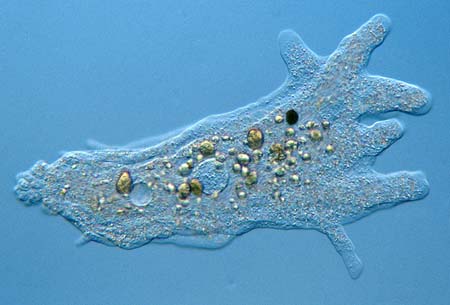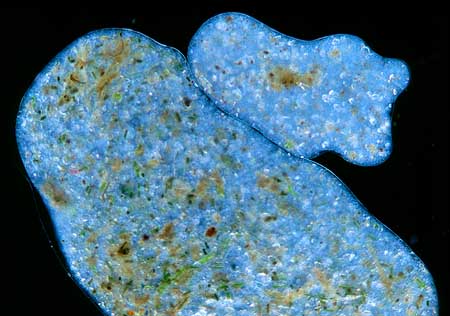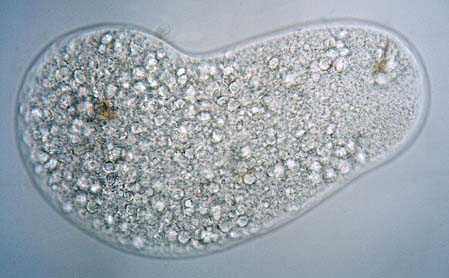by Wim van Egmond, The Netherlands

Amoeba proteus, click to enlarge for more detail
|
by Wim van Egmond, The Netherlands
|

Amoeba proteus, click to enlarge for more detail |
| One
of the most enigmatic microscopic life forms is the amoeba. Almost everyone
knows what amoeba are, which is quite remarkable since they are not that
common. Microorganisms like rotifers are much easier to find but drop the
name 'rotifer' in a conversation and most people will not know what you
are talking about. But mention the word 'amoeba' and people will say: 'Yes,
you mean those critters that can take any shape they like!'
They are legendary as the ultimate 'shape shifters'. Despite their good publicity they remain much of a mystery. It is even quite hard to find them. They are easily overlooked since they are so transparent or not recognized as living organisms since they often resemble decaying organic remains. Some time ago I was asked if I could produce a series of images of microorganisms such as the Hydra, Paramecium and an Amoeba. I had to confess that I had never photographed an amoeba. So I tried to find out how to catch them. I read about the following method: Hold a jar upside down under water until it is situated just above the bottom of a pond. Then slowly tilt the jar to let the air escape. This way the top layer of the soil on the bottom of the pond will be sucked inside the jar. Many amoebas inhabit this top layer of decaying organic material. |

Two individuals of the giant Pelomyxa palustris, the biggest is almost 3 mm. |
When
I examined the catch under the stereo-microscope it looked like nothing
more than dirt but between it were some big gelatinous spheres. Then I
noticed that they were slowly moving. I had hit the jackpot. I found the
largest of them all. In this smelly pond 100 feet from my house lived giant
amoebas!
Pelomyxa palustris is the largest amoeba you can find in pond water. It inhabits the often oxygen poor mud on the bottom of ponds. They can become truly huge for a single celled organism. Some of them can be 5 millimetres, clearly visible with the naked eye! |
||
| Anatomy
The top image of Amoeba proteus, gives a good insight in the amoeba's anatomy. Amoebas have a single cell that appears to be not much more than cytoplasm held together by a flexible cell wall. Floating in this cytoplasm all kinds of cell bodies can be found. The most obvious is the nucleus. Some species have only one nucleus, others may have hundreds of nuclei. The right image of a small individual of Pelomyxa shows it has hundreds of nuclei. This could enable them to become so big. Apart from the nucleus, the cell may contain water expelling vesicles and all kinds of inclusions (digested food). Many species of amoeba also bear small crystals. |
 |
||
| When
you find an amoeba it may be a complicated task to determine the species.
Species may look very similar and the fact that they transform doesn't
make it easier. But amoebas are not just 'blobs'. Each species has its
distinct repertoire of shapes and appearance. Amoeba possess a kind of
inner structure that defines their range of forms. The 'looks' of amoebas
are a result of their so-called 'pseudopodia' (false feet) that come in
several types. Some amoeba have many 'pseudopods' (polypodial), Others
have only one (monopodial). Some groups have long extensions, almost like
spines.
Important clues for identification besides shape and size of the amoeba can be the shape and texture of the nucleus. The amount of nuclei can also be conclusive. A good example of how difficult identifying a species may be is Amoeba proteus. This attractive amoeba can be regarded as the 'prototype' amoeba. It is a relatively large species (sometimes more than half a millimetre) with a quite distinct appearance. But it is very easy to confuse this species for a very similar looking amoeba called Chaos carolinensis. (Which is in fact a more common species). Chaos differs because it has many nuclei while Amoeba proteus has one single nucleus. That is to say, most of the time. To make it more complicated, in some cases Amoeba proteus can be found with several nuclei. |
| Behaviour
If you observe their lifestyle you will find that amoebas are really sophisticated. The way amoebas locomote as well as feed is really puzzling. The following page shows the intriguing way they catch prey. |
|
Page 2: LOCOMOTION AND FEEDING
|
|
|
All comments to the author Wim van Egmond are welcomed.
Find
out more about microscopic pond life on The
Smallest Page on the web
The
Pond Life Identification Kit may help
you identifying small freshwater organisms
Visit Wims home page for links to his many web pages on microscopy
Please report any Web problems or
offer general comments to the Micscape
Editor,
via the contact on current Micscape
Index.
Micscape is the on-line monthly magazine
of the Microscopy UK web
site at Microscopy-UK